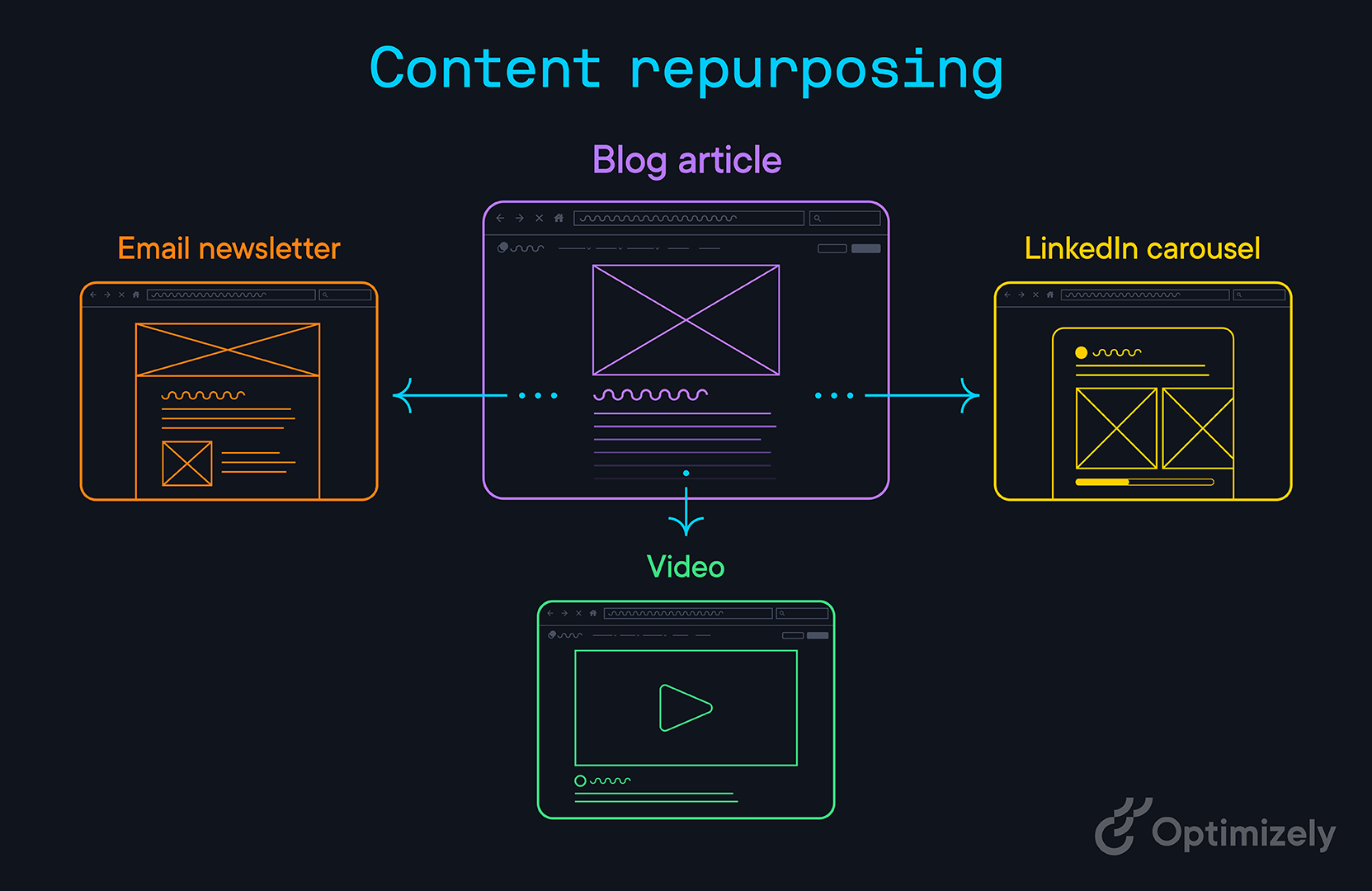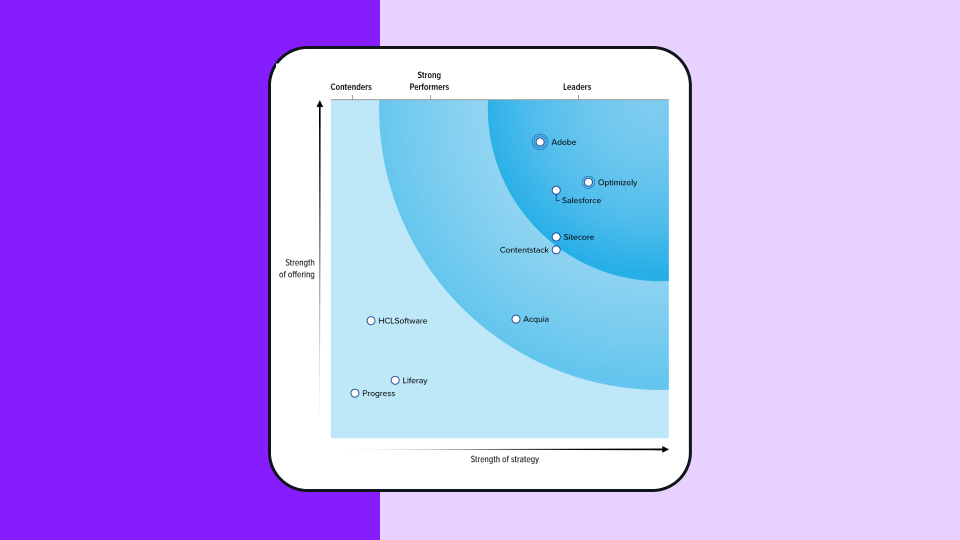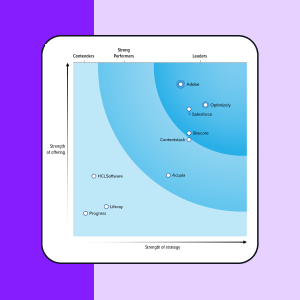Content repurposing
What is content repurposing?
Content repurposing means recycling existing content into different formats for new audiences across various channels. It's not simply re-releasing identical content or borrowing from other brands.
In today's content-hungry world, the "create-publish-forget" approach wastes resources. Content repurposing offers a smarter alternative, extending content lifecycles and maximizing value from existing assets.
As one marketing professional puts it: "Repurpose 👏 Your 👏 Content." The "one and done" mentality has no place in modern marketing.
When it comes to content repurposing, you might (/should) include this in your marketing strategy to:
- Experiment with different formats of content
- Reach new audiences or markets
- Fill marketing calendars with minimal extra work
- Align your brand messaging
- Continue to give new life to your killer content
The role of AI in content repurposing
How many times have you heard "Just stick it in ChatGPT and see what it does with it" when it comes to repurposing or rewriting content?
Wait, we already know the answer: a lot.
Yes, AI can repurpose content. Yes, it can take an existing long-form piece of content (like a blog) and snip it up into a range of short-form content pieces like social media posts, LinkedIn carousels, infographics, landing page copy, video scripts - the whole shebang.
BUT make sure you're properly checking through the content that AI produces and making your own edits, particularly when it comes to your brand's messaging and tone of voice.
One of the biggest brand messaging mistakes you can make is to rely entirely on AI; you know your brand better than any robot ever will, after all. Bring the personality, bring the vibes, and - please - ditch the whole "in today's competitive landscape..." AI spiel.
How to choose which content to repurpose
Don’t repurpose content just for the sake of it. Instead, you should target pieces of content that make sense to rework and republish in a new format.
Here are some questions to ask yourself to help decide the best content to repurpose next:
-
What’s your top-performing content?
Take a look at your Google Analytics account, check out what's getting the most engagement and shares on social media, hear from your account managers or customer success managers what their clients are shouting about.
This will give you a good idea of the kind of high-quality content that is worth repurposing. -
Where are you seeing gaps in the SERPs, in terms of content formats?
When it comes to writing a blog, you do keyword research, right? This keyword research might show up where there are some gaps in the content, in terms of content format.
For example, you might see there's an opportunity for a YouTube video on the topic; not only could this benefit your YouTube channel, but also provide some good snippets for social. Or how about the other way round? You've got a great webinar or video tutorial that gets a lot of engagement, why not take the transcription, do a bit of editing, and turn it into a written tutorial or key takeaways post? -
What type of content does best for engagement on each social media platform?
With a bit of experimenting and research between each of your teams, you'll find out what type of content works best on each platform. Your social media team will be especially clued up on this - user engagement is kinda their jam.
Think about the target audience or audience segments on each social media channel when ideating on content. -
Is there any old content that needs to be updated?
Things change, rebrands happen, new products or acquisitions come to light. However, you still want to make sure you're maintaining brand consistency.
Your blog, for example, is almost definitely home to many old or outdated posts. Content optimization is always beneficial - in fact, content repurposing can give these oldies a new lease of life, and might even inspire new content too. While evergreen content is obviously intended to remain evergreen, you should keep an eye on these too - especially your big-hitters in terms of traffic and engagement. -
Which content pieces are used (or do well) across the company?
As content is king (and don't we know it), the whole company will be using marketing content in some way or another. Think about outbound emails, one-pagers, client or prospect feedback, or your colleague's well-performing LinkedIn post... holla at you, employee advocacy.
Use metrics behind these to inspire your content repurposing strategy further.
The benefits of repurposing content
There’s a reason why content repurposing is part of most content marketing strategies; it’s worthwhile. Here’s why you should be doing it:
- Maximizes your content value: There are no limits to the number of times you can recycle an asset or the number of formats it lives in. If you have a great piece of content that you know performs well (or could perform better elsewhere), content repurposing allows you to squeeze every drop of juice from it.
- Improves the reach of your content: Repurposing content can help you reach new audiences and expand your online presence with new or different marketing channels. Maybe your target market has grown since you first published the original piece, in which case repurposing offers an easy way of connecting to new people.
- Boosts your SEO rankings: Another thing that content repurposing is good for is improving your visibility on search. Publishing multiple pieces of content around a single keyword will boost your position in search engines. Plus, by linking the repurposed asset back to your website, you'll also help to improve your content ranking for different keywords. Optimization, don't we just love it?
- Gains new followers: By promoting your content on different channels and platforms, you'll see that additional reach turn into a greater following too, particularly on social media, email newsletters, and video platforms like YouTube.
- Keeps things on-brand: If your original asset is on-brand (and on-point), then repurposing the content is going to let you create, publish, and promote content that strengthens the brand message across every format and channel. This will do wonders to your brand identity and not require too much of your team's time.
- Personalizes content: Personalization is what marketing is all about these days, and that means publishing relevant content across relevant channels. Content repurposing allows you to republish existing content and engage different audience segments in the formats they prefer.
- Maintains publishing frequency: One of the key pillars of a successful content marketing strategy is the regular posting of fresh content. Repurposing old content and transforming it into new, sexy content allows you to keep pushing out high-quality materials on different channels without having to stress over creating new content around the clock.
How to repurpose your content
First, let’s take a look at all the different content formats out there that you can bring into your digital marketing strategy:
-
Blog articles (long-form and short-form)
-
Guest posts on other sites
-
Social media posts
-
Infographics
-
Case studies
-
Podcast episodes
-
Webinars
-
Video content (eg. YouTube videos and of course, TikTok)
-
Downloadable templates (man, do people love those)
Each type of content mentioned, can be transformed into another type of content mentioned. Or even better: multiple pieces of content.
And that’s just digital marketing. Don’t forget to think about other marketing formats too, like white papers, out-of-home marketing campaigns, one-pagers for events, and so on.
Let’s take a look at this example of content how blog content can be repurposed into new content pieces:

Image source: Optimizely
Best practices for content repurposing
Using AI to repurpose content helps you get better content out the door through:
- Automated Transcription: Convert audio/video to text, create summaries, and extract quotes
- Format Conversion: Transform blogs into social media, case studies into infographics, reports into videos
- Platform Optimization: Adjust content length, suggest hashtags, optimize headlines, and personalize for different audiences
- Content Briefs: Generate detailed outlines with subtopics and CTAs, saving creative energy for high-value tasks
And here are six essential best practices for effective AI-powered repurposing:
- Start with quality content: Focus on evergreen, high-performing assets aligned with objectives
- Tailor to platforms: Consider each platform's audience and adapt style accordingly
- Keep content fresh: Update statistics and examples to maintain relevance
- Add new value: Include additional insights rather than simply reformatting
- Balance AI with human touch: Address AI limitations in originality, accuracy, and emotional intelligence
- Track performance: Measure engagement, ROI, and conversion rates across formats
Useful tools for content repurposing
Here are useful options for content repurposing, that can extend the life of your assets and keep the content fire burnin':
- Content management system (CMS): Provide cross-functional content management with a central repository for content.
- Digital asset management (DAM): Store all assets in a centralized system to make them easy to find and easy to repurpose for the team.
- Content marketing platform (CMP): Align team members and other departments with simple, clear workflows for campaigns and tasks.
- AI transcription and summarization: Tools like Descript convert audio/video content into editable text, creating foundations for multiple content pieces.
- AI design and visualization: Canva with AI features and similar tools (Gamma AI) convert text content into visually appealing graphics, infographics, and presentations.
For example, with Opal AI, you can generate fully fleshed-out campaigns tailored to specific target audiences in seconds.
Here's how:
Also, to make content repurposing a consistent and rewarding process, you need omnichannel marketing.
Omnichannel marketing is more than just multi-channel marketing, it's about the integration of your strategy, technology, and operations.
Equipped with AI-enabled ideation and generation, SEO analysis, and collaborative tools like workflows and inline commenting, omnichannel platforms make the whole process really, really efficient.
And thanks to integrations, once your content is created and approved in the omnichannel editor, you can push it to, well, pretty much anywhere — all without ever leaving the CMP.
Squeeze the marketing lemon with content repurposing
We’re all about getting the most out of what we’ve got, and that includes existing content. Content repurposing is a win-win for all marketing departments because it means less work, more alignment, and zero time wasted.
Team collaboration and alignment is essential to the process, so everyone knows what marketing goals you’re working towards, what projects and campaigns are being worked on, and what message they’re putting out.
Building a more integrated marketing team can significantly enhance this alignment, helping you streamline efforts and achieve consistent results.

